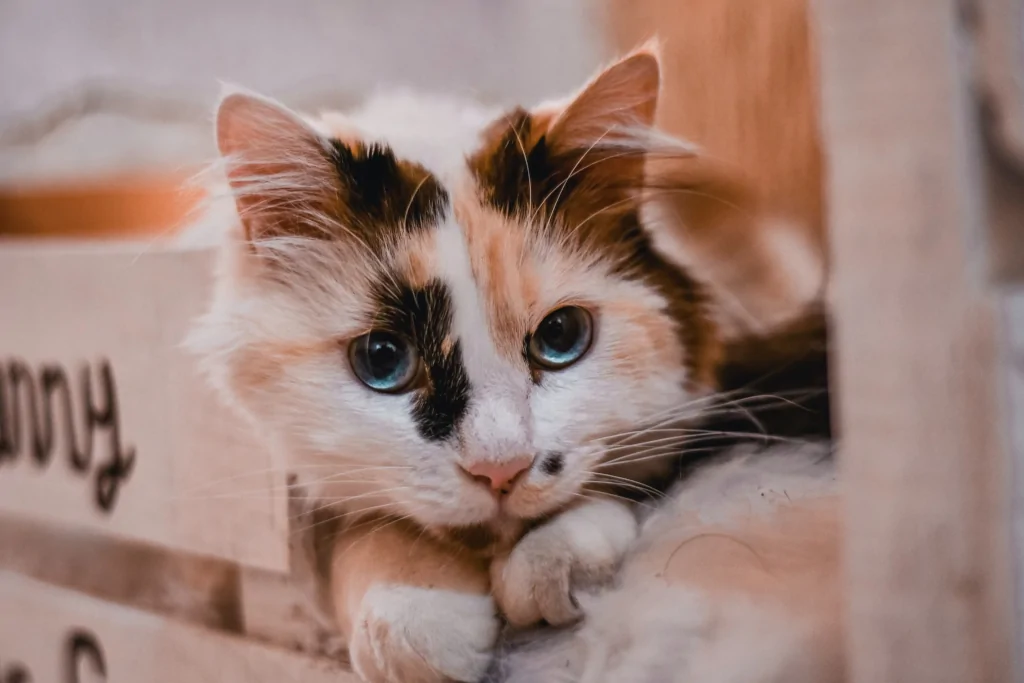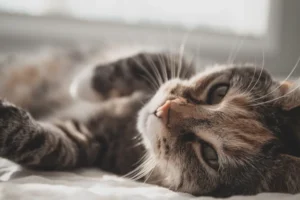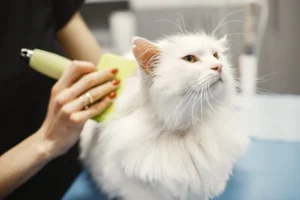As cat owners, we know that the health and happiness of our feline friends are among our top priorities.
But when unexpected medical expenses come up, it can leave us feeling stressed and financially strained. That’s where cat insurance comes in, offering peace of mind and protection for our beloved companions.
In this blog post, we’ll delve into the world of cat insurance, uncovering its benefits and helping you make an informed decision to safeguard your pet’s future.

Why Should You Consider Cat Insurance?
Cat insurance is a worthwhile consideration for any cat owner who wants to be prepared for the unexpected.
Accidents and illnesses can happen at any time, and the cost of veterinary care can quickly add up. By investing in cat insurance, you’re not only protecting your cat’s well-being but also ensuring that you won’t have to compromise on the quality of care due to financial constraints.
Moreover, having insurance can help alleviate the stress of unforeseen expenses, allowing you to focus on your cat’s recovery and return to their playful, purring self.
Understanding the Different Types of Cat Insurance Policies
Accident-Only Coverage
Accident-only policies cover the cost of veterinary care for injuries resulting from accidents, such as broken bones, poisoning, or injuries caused by other animals. These plans are typically the most affordable option but won’t cover illnesses or routine care.
For example, when Smokey, my curious cat, accidentally swallowed a small toy, our accident-only policy helped cover the cost of his emergency treatment.
Comprehensive Coverage
Comprehensive policies provide coverage for both accidents and illnesses, ranging from minor infections to chronic diseases like diabetes or cancer. These policies often come with higher premiums but offer more extensive coverage for a variety of conditions.
Investing in comprehensive coverage ensures that your cat is protected no matter what health issues they may face.
Wellness and Preventive Care
Some cat insurance policies offer additional wellness and preventive care coverage. These plans cover routine veterinary care such as vaccinations, dental cleanings, and annual exams.
Adding this coverage to your policy can help you manage the costs of maintaining your cat’s health and catching potential issues early on.
Customizable Coverage
Several insurance providers allow you to customize your policy to fit your cat’s specific needs and your budget. You can adjust the deductible, annual limit, and reimbursement percentage to create a plan that works best for you.
Customizable coverage gives you the flexibility to balance cost and coverage, ensuring your cat receives the care they need without breaking the bank.
As you consider the various types of cat insurance policies, think about your cat’s unique needs, your financial situation, and the level of coverage that will give you peace of mind. In our case, after Smokey’s toy-swallowing incident, we decided to upgrade to a comprehensive policy to ensure he would be covered for any future accidents or illnesses.
Comparing Providers: What to Look For in Coverage
Coverage Options
When comparing cat insurance providers, start by examining the types of coverage they offer. Look for companies that provide accident-only, comprehensive, wellness and preventive care, and customizable policies.
This will give you the flexibility to choose the coverage that best suits your cat’s needs and your budget.
Reimbursement Rate and Deductible
Pay attention to the reimbursement rate and deductible options offered by each provider. A higher reimbursement rate means you’ll receive more money back on your claims, while a lower deductible means you’ll pay less out-of-pocket before your insurance kicks in.
Consider your financial situation and how much you’re willing to spend on veterinary care before choosing a plan with the right balance of reimbursement rate and deductible for you.
Try to estimate your cat’s potential future medical expenses. By doing so, you can better determine the level of coverage you need and ensure that the policy you choose provides adequate financial protection in case of unexpected veterinary bills.
Waiting Periods
Some insurance providers have waiting periods before the coverage becomes effective. This is the time between when you sign up for the policy and when the coverage starts.
Look for providers with short waiting periods, especially if your cat has an existing condition or is prone to accidents.
Exclusions and Pre-Existing Conditions
Review the list of exclusions and limitations for each insurance provider. Some companies may not cover certain conditions or treatments, so it’s important to understand what is and isn’t included in the coverage.
Additionally, check their policy on pre-existing conditions to make sure your cat will be covered for any ongoing health issues.
Customer Service and Claims Process
A reliable insurance provider should have excellent customer service and a straightforward claims process. Read customer reviews and testimonials to get a sense of the company’s reputation and responsiveness.
When Smokey needed surgery, our insurance provider’s customer service team was extremely helpful and made the claims process easy to navigate, which was a huge relief during a stressful time.
Network of Veterinarians
Some cat insurance providers require you to use a specific network of veterinarians, while others allow you to choose any licensed veterinarian.
If you have a preferred veterinarian or live in an area with limited options, make sure the insurance provider’s network aligns with your needs.
By comparing providers based on these factors, you’ll be able to find the right cat insurance policy that provides the coverage you need at a price that fits your budget.

The Claims Process: How Does It Work?
By understanding how the claims process works, you’ll be better prepared to navigate it when the time comes. A smooth and efficient claims process can help reduce stress and ensure your cat gets the necessary care without delay. Here’s a general overview of how the claims process typically works:
- Visit Your Veterinarian
When your cat needs veterinary care, take them to your preferred licensed veterinarian or an in-network provider, depending on your insurance policy’s requirements. If you haven’t chosen the vet yet, check our guide on choosing the right vet for your cat.
Once you’re there, inform the veterinarian that you have cat insurance, but don’t worry – you won’t need to handle any paperwork just yet.
- Pay for Services Upfront
Unlike human health insurance, pet insurance usually requires you to pay for veterinary services upfront. Be prepared to cover the expenses at the time of the visit and obtain a detailed invoice from the veterinarian outlining the treatments and their costs.
- Submit Your Claim
After paying for the services, submit a claim to your insurance provider. This typically involves completing a claim form and attaching a copy of the invoice from your veterinarian.
Most providers offer convenient online claim submissions, while others may require you to mail or fax the documents.
- Wait for Approval and Reimbursement
Once your claim is submitted, your insurance provider will review the information and determine the reimbursement based on your policy’s coverage, reimbursement rate, and deductible.
The approval process can vary in duration, typically taking anywhere from a few days to several weeks. If approved, you’ll receive a reimbursement payment via check or direct deposit.
- Follow Up on Denied Claims
If your claim is denied or you have questions about the reimbursement amount, don’t hesitate to contact your insurance provider’s customer service team for clarification. They can help explain the reasoning behind the decision and guide you through any necessary steps to appeal the claim, if applicable.
Remember, the goal is to ensure your cat gets the care they need without putting unnecessary financial strain on you. Choose a policy with a claims process that is transparent, user-friendly, and efficient to make the experience as stress-free as possible.
Tips for Choosing the Right Policy for Your Cat’s Needs
Selecting the perfect insurance policy for your cat can be overwhelming, but it’s essential to find one that suits their unique needs. Here are a few tips to help you make the right choice:
- Assess Your Cat’s Lifestyle and Health History. Consider factors like your cat’s breed, age, and medical history. When I adopted Smokey, a senior cat with a few pre-existing conditions, I made sure to choose a policy that would cover the specific needs of an older feline.
- Research Provider Reputation and Customer Satisfaction. Look for reviews and testimonials from other pet owners to get an idea of their experiences with different insurance providers. This will help you gauge the quality of customer service, claim processing times, and overall satisfaction with the coverage.
- Consider Deductible, Reimbursement Rate, and Coverage Limits. Weigh the deductible, reimbursement rate, and coverage limits against your budget and your cat’s needs. A higher deductible may result in lower premiums, but be prepared to cover more out-of-pocket costs.
- Evaluate Optional Add-Ons and Wellness Coverage. Some policies offer optional add-ons, such as dental care or alternative therapies. Depending on your cat’s needs, these extra coverages might be worth the additional cost.
With the right plan in place, you can ensure your feline friend stays happy and healthy for years to come.
FAQs
Can I insure a senior cat or a cat with pre-existing conditions?
Insuring a senior cat or a cat with pre-existing conditions depends on the insurance provider, as some may cover these cats with specific limitations or exclusions.
Does cat insurance cover routine vet visits and vaccinations?
Cat insurance may cover routine vet visits and vaccinations if you choose a policy with wellness coverage or an optional wellness add-on.
How long does it take to process an insurance claim?
The time it takes to process an insurance claim varies by provider, but it usually takes anywhere from a few days to several weeks.
Can I change insurance providers if I’m not satisfied with my current plan?
You can change insurance providers if you’re not satisfied with your current plan, but keep in mind that any pre-existing conditions from the previous policy may not be covered by the new provider. Do some research before you commit, and read this guide often for instructions on what to look for.
Alex, a passionate animal lover, has experience in training and understanding animal behavior. As a proud pet parent to two dogs and three cats, he founded AnimalReport.net to share insights from animal experts and expand his knowledge of the animal kingdom.




